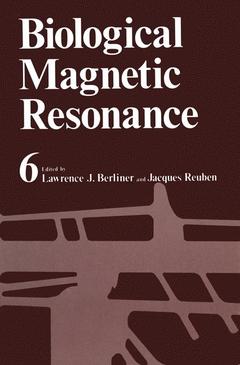Description
Biological Magnetic Resonance, Softcover reprint of the original 1st ed. 1984
Volume 6
Biological Magnetic Resonance Series, Vol. 6
Coordinator: Berliner Lawrence
Language: English
Subject for Biological Magnetic Resonance:
Publication date: 04-2012
300 p. · 15.2x22.9 cm · Paperback
300 p. · 15.2x22.9 cm · Paperback
Description
/li>Contents
/li>
We have now reached our sixth volume in a series which has somewhat unintentionally become an annual event. While we still intend to produce a volume only if a suitable number of excellent chapters in the forefront of biological magnetic resonance are available, our philosophy is to present a pedagogical yet critical description and review of selected topics in mag netic resonance of current interest to the community of biomedical scien tists. This volume fulfills our goals well. As always, we open the volume with a chapter which directly addresses an in vivo biological problem: Phil Bolton's presentation of new techniques in measuring 31 P NMR in cells. Lenkinski's chapter on the theory and applications of lanthanides in protein studies covers the details, highlights, and pitfalls of analysis of these com plexes in biochemical NMR. Reed and Markham summarize the interpreta tion of EPR spectra of manganese in terms of structure and function of proteins and enzymes. Dalton and colleagues describe the applications to biological problems of the relatively new capability of time domain ESR. Finally, we are pleased to offer a departure from mainstream magnetic resonance with the comprehensive and stimulating chapter by Gus Maki on the theory, instrumentation, and applications of optically detected magnetic resonance.
1 Two-Dimensional Spectroscopy as a Conformational Probe of Cellular Phosphates.- 1. Introduction.- 2. Basic Principles of Heteronuclear Two-Dimensional NMR.- 3. Analysis of Heteronuclear Two-Dimensional NMR Spectra.- 4. Experimental and Instrumental Considerations.- 5. Range and Limitations of Heteronuclear Two-Dimensional NMR.- 6. Long-Range Spying: Relayed Transfer Spectroscopy.- 7. Heteronuclear Zero Quantum Spectroscopy.- 8. Future Applications and Developments.- References.- 2 Lanthanide Complexes of Peptides and Proteins.- 1. Introduction.- 2. Chemistry of the Lanthanide Ions.- 3. Theoretical Background.- 4. Proteins.- 5. Peptides.- 6. Conclusions.- References.- 3 EPR of Mn(II) Complexes with Enzymes and Other Proteins.- 1. Introduction.- 2. EPR Properties of Mn(II).- 3. Experimental Methods.- 4. The Spin Hamiltonian.- 5. Evaluation of ZFS Parameters.- 6. Applications.- 7. Summary and Prospects.- Appendix I: FORTRAN Program for Simulation of Mn(II) Powder EPR Spectra.- References.- 4 Biological Applications of Time Domain ESR.- 1. Introduction.- 2. Pulsed EPR Experiments.- 3. Instrumentation.- 4. Comment On The Future Of Pulsed EPR Techniques.- References.- 5 Techniques, Theory, and Biological Applications of Optically Detected Magnetic Resonance (ODMR).- 1. Introduction.- 2. The Photoexcited Triplet State.- 3. Theory and Methods of ODMR.- 4. Experimental Considerations.- 5. ODMR of Biologically Significant Molecules.- References.
© 2024 LAVOISIER S.A.S.
These books may interest you

Spin LabelingThe Next Millennium 158.24 €



